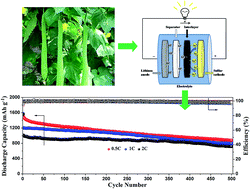A free-standing sulfur-doped microporous carbon interlayer derived from luffa sponge for high performance lithium–sulfur batteries†
Abstract
Luffa sponge, as a renewable precursor, is used for the first time to synthesize sulfur-doped microporous carbon (SMPC), which is subsequently rolled into an SMPC interlayer that acts as the polysulfide diffusion inhibitor between a sulfur cathode and separator in a Li–S battery. Instrumental analysis shows that the obtained SMPC possesses a unique microporous carbon framework, large specific surface area (3211.2 m2 g−1), high pore volume (1.72 cm3 g−1), good electrical conductivity (1.89 S cm−1) and in situ S-doping (2.72 at%). Due to the special physical properties and chemical ingredients of SMPC, the as-fabricated SMPC interlayer for Li–S batteries can not only facilitate rapid electron and Li ion transfer, but can also effectively sequester dissolved polysulfides through combining strong chemical and physical absorption. Consequently, Li–S batteries containing the SMPC interlayer deliver a high initial reversible capacity (1544.2 mA h g−1 at 0.2C), superior rate capability (781.2 mA h g−1 at 5C), and excellent cycling stability (over 500 cycles at 2C with 0.057% capacity fading per cycle). This eco-friendly, low cost SMPC interlayer can offer an appealing alternative for the commercialized production of Li–S cells.


 Please wait while we load your content...
Please wait while we load your content...